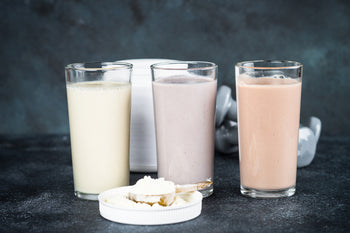 Categories
CategoriesDiet & Exercise
Discover More Articles

It’s no secret that stress can take a toll on our body, mind, and brain. December is not the month to throw your self-care and mental health priorities out the window.

5 Ways to Stay Motivated This Winter
When the seasons change it suddenly becomes harder to get out and exercise. Winter fitness programs aren’t the easiest to stick to, but they’re imperative to your overall health and well-being. So with that in mind, let’s take a look at what you can do to stay motivated and successful with your winter fitness goals.

How to Detox After Holiday Feasts
If you’re having a hard time committing to your diet over the holidays, you’re not alone. And the good news is you don’t have to be perfect to maintain your weight over the holiday season. Try following these simple detox tips after each scrumptious holiday meal and start the new year fresh and ready to finally achieve your health and fitness goals.

High Protein Meal Replacement Shakes
Meal replacement shakes aren’t just low in calories, they’re high in essential nutrients your body needs to keep yourself nourished and your stomach feeling full, while helping also you maintain or lose weight. Protein provides numerous benefits to your body, including fueling the entire body, helping build muscle mass and being a key component to essential substances your body needs, like antibodies and blood.

Skin Cycling: all about the newest trend
The skin cycling hashtag has been viewed over 3 billion times on TikTok—and dermatologists say it's a strategy worth trying.The term "skin cycling" is all about taking a cyclical approach to your facial skincare routine.

Get ready for a plumper, perkier-looking neckline
Meet our new luscious neck cream featuring our proprietary elasticizing bioactive plant blend that targets lines and texture, so your neckline appears smoother, renewed & 10 years younger looking!

TRENDING MAKEUP HACK: BLUSH & BRONZER AS EYESHADOW
By selecting shades that complement each other, you can achieve a harmonious and polished makeup look without the need for multiple products.

5 signs you need more electrolytes
Electrolytes help with hydration by ensuring the body can actually absorb and use the water you drink—preventing dehydration in the presence of sufficient water intake.

Ring In 2025 With ✨ Glowing ✨ Skin…And FREE Boosters!

Better Ingredients, Better You
Your health goals aren’t one-size-fits-all, so your supplements shouldn’t be either. That’s why we designed the Power Line to target different pillars of performance and wellness — from appetite control to anti-aging to athletic power.

If only texting and typing could be called aerobic workouts!
Alas, our modern lifestyle leads many of us to become too sedentary, meaning that we sit far too long during the day to promote healthy bodies. Unlike our ancestors, whose very survival often depended on being able to physically work long, arduous hours, we often have to schedule time to get even a minimum amount of exercise.
Yet moving and exercising our bodies promotes feelings of wellbeing, clears the head and reduces stress, and strengthens multiple bodily systems and functions that maintain health. Regular aerobic exercise doesn’t have to be exhausting and painful in order to be beneficial.

The Differences between Aerobic and Anaerobic Exercises
The word “aerobic” means that an activity occurs in the presence of oxygen. The prefix “an” means “not,” “without,” or “lacking.” Therefore, aerobic exercise allows the body to utilize oxygen as part of the fuel-burning process, while anaerobic exercise does not.
When you exercise at a low or moderate level, you can sustain the activity for long periods of time (depending on your stamina levels, of course). As your heart rate increases, you breathe more quickly and deeply, which gets more oxygen into your lungs and blood. This allows your body to burn both sugar (glucose) and fat as fuel.
Anaerobic exercise, on the other hand, is very high intensity exercise that only lasts for short periods of time and is good for building muscle mass. Think of the differences between a sprinter and a marathon runner, for instance: the sprinter runs fast and hard for a minute or less, while the marathon runner is going at a much slower pace for hours.
Aerobic exercise is often also called cardio because it strengthens the heart muscle over time, which boosts circulation and, thus, the amount of oxygen that is delivered to tissues and organs (including your brain!).
Both aerobic and anaerobic exercise do good things for your body, and a combination of both types of exercises is a great way to strengthen your heart and also build muscle mass.

Aerobic Exercise Factors
Regularity, Intensity, and Duration
Regularity
One two-mile jog a month will make you sore, but it won’t increase your stamina, strengthen your heart, or help you burn fat. For aerobic exercise to produce benefits, you need to be doing it on a regular basis. Three to five days a week for at least 20 minutes at a time will allow you to see positive changes within just a couple weeks. Odds are that the benefits you are feeling will begin to be their own motivation to keep going.
Intensity
The most beneficial type of aerobic exercise happens at a moderate intensity. Because each person is at a different level of fitness and stamina, your moderate rate of exercise might be different than someone else’s.
The best way to measure what is appropriate for you is to determine what your target heart rate for moderate exercise should be and then work to stay within that target range. Talk with your health provider before starting an exercise program or use this formula to determine your target heart rate. If you are out of shape, a snappy walk might be all that you need to get you to your target. If you are very fit, a fast jog (or more) might be required.
In general, though, if you are exercising hard enough that you can’t carry on a conversation (even if it’s a bit breathless), you’re doing the exercise too hard for it to be of moderate intensity. Back off just a bit. Exercising in your target heart rate range for moderate intensity will keep you breathing harder than you would at rest without making it impossible to carry on a conversation.
Duration
The third factor of aerobic exercise is duration. The length of time you spend exercising will help to increase your oxygen intake and, therefore, strengthen your heart as well as feed oxygen to your cells, tissues, and organs. You need at least 20 minutes of moderate exercise at a time to call it an aerobic exercise.
Getting Started
If you’re just starting a new aerobic exercise program after months or years of living a sedentary life, don’t feel the need to immediately pick up one of the high-intensity programs that are so popular today. That route can lead to injury and burnout very quickly.
Instead, make a list of exercises you enjoy (i.e. walking, hiking, swimming laps, gardening, biking, jogging, rowing, jazzercise, etc.), calculate your target heart rate for moderate exercise, and then find an exercise buddy, join a gym and take classes, or just get outside and begin. As you gain strength and stamina, you can increase the level of intensity. You’ll find you love the way you feel when you regularly engage in moderate aerobic workouts.
